Soil fertility
- Fodder beet has certain nutrient requirements to achieve its yield
- Soil test paddock(s) 6-12 months to a depth of 150 mm before planting. This allows time for pH or nutrient issues to be addressed. Apply and incorporate all base fertiliser before planting.
pH
The soil pH should ideally be 6.0-6.3. It can take 6 months or more for lime to act (depending on incorporation, weather, and the type of lime used), so apply this as early as possible. As a rule of thumb, 1 t/ha lime raises the pH by 0.1.

Correct soil fertility results in healthy, high yielding crops.
Phosphorus
Phosphorus is an essential element for plant establishment and overall yield. Target Olsen P level for fodder beet is 15 or higher. Typically crops benefit from applications of 25-50 kg P/ha as a base dressing.
Nitrogen
Before cultivation, soil test to 150 mm deep for anaerobically mineralisable nitrogen (AMN). As a guide:
- If AMN >80 ug/g, 50 kg N/ha is required.
- If AMN <80 ug/g, up to 100 kg N/ha may be required.
Research has shown there is no yield advantage to applying more than 100 kg N/ha.
Timing is important - apply 50% at sowing and 50% before canopy closure.
Potassium
Fodder beet requires soil potassium quick test levels of 5+. As a rule of thumb, if the soil test result is lower than 3, apply 100 kg K/ha. If it is 3-5, apply 50 kg K/ha.
Sulphur
If the sulphur quick test result is below 5, apply at sowing
Magneisum
Recommended quick test soil levels for fodder beet are 8+. If magnesium is required apply 25-30 kg Mg/ha as a base fertiliser.
Sodium
If quick test soil values are less than 5, apply 150 kg NaCl/ha as a base fertiliser.
Boron
Boron is essential for root crop development. If soil test results are less than 1 parts per million (ppm), include 1.5 kg B/ha in the starter fertiliser, e.g. granular boron (15% B) at a rate of 10 kg/ha.

